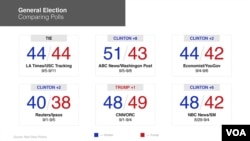On November 8, the American people will vote for the next U.S. president in this year’s general election.
Donald Trump is the Republican Party candidate and Hillary Clinton is the candidate for the Democratic Party.
Before election day, people following the presidential campaign will see many polls.
A poll is a public opinion study. Research organizations ask people questions about the candidates to find out who they support.
For example, one of the polls is run by a professor at a university in the U.S. state of Connecticut. People who work for the polling service call likely voters on the telephone.
They ask the person who answers the call questions about the election. In most cases, it is “if the election were held today, and the candidates were Hillary Clinton and Donald Trump, for whom would you vote?”
Sometimes the questions include more candidates or are related to campaign issues.
Since the party conventions this summer, Clinton has held a lead over Trump in most national opinion studies.
The website RealClearPolitics shows that Clinton leads Trump by about three percentage points in an average of national polls.
But sometimes the poll numbers change.
On September 6, a poll was released showing Trump slightly ahead of Clinton. This can be confusing for many observers.
How can one poll be so different from others?
Here are some things to remember when you are looking at polls:
Poll averages are better than a single poll
It is better to look at websites that combine the results of several polls to get the best idea of national opinion.
Not all polling groups are the same
Some polls target specific groups of people. Many polls make sure they collect many different opinions. Sometimes, however, polling organizations receive money from groups that support a specific political issue. It is important to look at which group carried out the poll along with the results.
A poll’s method is important
Some polls are using new technology. Traditionally, polls are done over the phone. But that is slowly changing. Many polls are now done online. While online polls can produce good information, it is sometimes hard to reach as many different types of people over the Internet.
Also important is the size of the poll. Try to find out how many people were polled before believing its results.
The state in which a poll is carried out also is important
Polls that study opinion in states where one candidate does not have a clear lead are the most important.
According to the politics website Politico, those states include Ohio, Pennsylvania, Florida, Virginia, Wisconsin, Colorado and Iowa.
These states are known as “swing states,” because the voting there may “swing” the election in the direction of one candidate.
Swing states are important because the candidate who gets the most popular votes does not always win the election. The election winner is the candidate who gains the most electoral votes in the electoral college. A state’s electoral college votes are generally determined by the popular vote in each state.
Polls are not predictions
Polls only show how people feel at one moment in time. They do not show what will happen in the future. Public opinion may change before the general election on November 8. Some things that could change the opinions of voters include: the debates on television, the release of the candidates’ tax or medical records, and unexpected illnesses.
I’m Dan Friedell.
William Gallo wrote this story for VOANews.com. Dan Friedell adapted it for Learning English. Mario Ritter was the editor.
Will you be following the polls ahead of the U.S. election? We want to know. Write to us in the Comments Section or on our Facebook page.
_______________________________________________________________
Words in This Story
general election –n. a regular election that involves voters and candidates throughout an entire country
poll – n. an activity in which several or many people are asked a question or a series of questions in order to get information about what most people think about something
swing – v. to move backward and forward or from side to side while hanging from something








